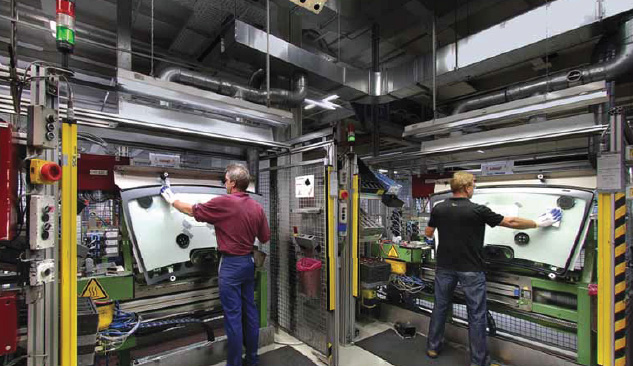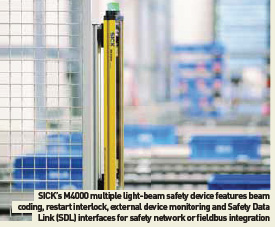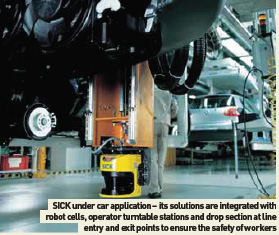
Without the right level of protection, assembly can be a hazardous place. Thankfully there is a plethora of barrier-free innovations designed to make even the most automated lines safe for all workers
For all its benefits, it is easy to forget that with automation comes the responsibility to integrate safety systems that will protect workers within areas of automatic motion. Where physical barriers are not viable because of high-volume production demanding a regular feed of components and/or sub-assemblies, there is a greater need for innovative light beam solutions such as light curtains and light grids. Here, a select band of global suppliers dominate the sector with their constant innovation and rapid time-to-market.
 One such company is SICK, a global leader in industrial sensors, and one of the world's top three suppliers of safety systems to meet the demands of ever-evolving legislation. SICK adopts two approaches that work hand-in-hand with the automotive industry. A corporate solution centre looks at technology and manufacturing trends within the sector to help develop solutions to meet current and future requirements within the industry. With global account management, SICK’s automotive industry teams are strategically organised to provide local support where major automotive manufacture and development takes place, including Germany, Italy, Sweden, France, the US, Japan, China, South America and the UK.
One such company is SICK, a global leader in industrial sensors, and one of the world's top three suppliers of safety systems to meet the demands of ever-evolving legislation. SICK adopts two approaches that work hand-in-hand with the automotive industry. A corporate solution centre looks at technology and manufacturing trends within the sector to help develop solutions to meet current and future requirements within the industry. With global account management, SICK’s automotive industry teams are strategically organised to provide local support where major automotive manufacture and development takes place, including Germany, Italy, Sweden, France, the US, Japan, China, South America and the UK.
Thomas Schott, Vice President of Factory Automation at Siemens Automation & Drives facility in Nuremberg, recently highlighted a number of automotive trends based on a bodyshop cell at a Volkswagen plant in Mexico. “At the VW bodyshop in Mexico we have been developing a state-of-the-art automation concept that demonstrates how capital expenditure and lifecycle costs can be reduced. Such a concept naturally integrates safety systems based on Profinet,” he continued. “The entire production plant is networked, including safe and non-safe applications. Our new panel PCs enable ergonomic plant operation and rapid troubleshooting via integrated diagnostic mechanisms. Wireless technology is also applied in bodymaking. “Profinet has taken a further step forward by integrating safety systems in the form of Profisafe, now boasting an innovative combination of wireless and open communications via IWLAN. While it was previously impossible to replace trailing cables or slip rings because of the use of safety systems, Profinet can now save substantial costs thanks to its Profisafe and IWLAN technologies. “Their full integration into the entire system has also made complex safety systems considerably simpler and more efficient to implement. Based on this automation concept, up to 35 per cent of capital expenditure can be saved for this particular work cell,” he says.
Different safety needs for automation
SICK’s systematic and transparent safety solutions include light curtains, light grids, safety scanners, proximity sensors, safety position switches, safety locks, safety switches, safety network solutions and controllers. “(Our) automotive applications are in all areas of the production process, from the parts suppliers, though to stamping, body-in-white, paint, trim and final assembly,” explains Seb Strutt, Safety Systems Product Manager for SICK in the UK.
“Most commonly, our solutions are integrated with robot cells, operator turntable stations and drop sections at line entry/exit points. We are also heavily involved in the logistics chain providing identification technology based on cameras, RFID and 2D code reading.” Strutt has his own views on the relationship between automation and safety.
“Robots have created a different set of safety awareness zones,” he says. “Areas were hazardous before but, by default, humans had to operate them and were thus more attuned to the hazards. Now we have the opportunity to create even less hazardous factories, but also need to create enhanced safety awareness in terms of design and operation.
“Despite all our developments in product technology, the automotive sector requires suppliers to be aware of the legacy they should support over the lifetime of the automotive production programme,” he continues. “Therefore we must innovate and maintain compatibility where possible.” Among the latest SICK safety innovations for automotive assembly lines is the C4000 self-teaching entry/exit safety light curtain and palletiser light curtains. These non-muting light curtains are used where material or machinery (such as a robot) is transported automatically into the hazardous area, while entry of people must be securely prevented. According to SICK, the technology is already being used by, among others, Jaguar, BMW, Daifuku and Honda. “C4000 technology means that it is always active and so dispenses with the need for muting sensors or muting lamps,” explains Strutt. “Therefore, installation, commissioning and maintenance costs are significantly lower. False alarms are also reduced,” he adds.
 The C4000 uses innovative ‘dynamic blanking’ technology to automatically ‘learn’ the profile of a pallet or vehicle transport system as it enters the light curtain, but triggers an alarm if a person tries to enter a hazardous area. As the light curtain is never muted, it is able to detect people walking next to the object as it travels through the protective field, therefore removing the requirement for side protection silhouettes or swing doors.
The C4000 uses innovative ‘dynamic blanking’ technology to automatically ‘learn’ the profile of a pallet or vehicle transport system as it enters the light curtain, but triggers an alarm if a person tries to enter a hazardous area. As the light curtain is never muted, it is able to detect people walking next to the object as it travels through the protective field, therefore removing the requirement for side protection silhouettes or swing doors.
The C4000 has a range of between 0.5 to 19 metres and a resolution of 20 millimetres. It learns profiles by monitoring the size of the parts of an object and their separation as it passes through the curtain at speeds of up to 2m/sec. Users can also specify a maximum allowable object size. Measurements are so precise that the curtain can tell the difference between contrasting transport skids and an operator’s legs, for example. Sophisticated algorithms in the curtain can detect someone walking through by the convergence of their legs.
The C4000 pallet entry/exit system is also being used at the PSA plant in Mulhouse, France on the Citroën C4 assembly line. “We were familiar with the system from various applications at PSA and thus with its advantages, particularly the fast, cost-saving installation and start-up, the robustness in operation achieved by the reduction of components, and the monitoring field that is completely active at all times,” says Patrick Adde from PSA Mulhouse.
Scientific Technologies (STI) has introduced the RM-5 resource module, which is essentially a microprocessor-controlled, multifunction relay that allows up to three light curtains to be connected in sequence. The RM-5 provides two NO and one NC force-guided safety contacts, while muting for conveyor/assembly line applications and presence sensing device initiation (PSDI) are also a function of this resource module which is CE approved and UL listed to satisfy global application requirements. PSDI is used to initiate the cycle of a machine or operation by counting the number of ‘breaks’ or obstructions of a presence sensing device (light curtain). Operating in PSDI mode allows for increased productivity because employees no longer need to make ‘nonvalue added’ movements to cycle machines. There is also an ergonomic advantage: by eliminating the need to press the cycle start switch(es), repetitive motion injuries caused by reaching for and pressing start switches are reduced.
Height and resolution can be customised Also recently introduced by the same company is the MiniSafe Flexible MSF4700 family of safety light curtains. The MSF4700 is engineered to withstand high shock and vibration environments typical of punch presses or other heavy industrial machinery. Its multi-segmented design allows it to protect up to four different openings by connecting up to four 35x50mm housings in sequence. Protected heights from 150 to 1800mm and resolutions of 14, 20 and 30mm are available, with unlimited combination possibilities. The ability to customise height and resolution for each light curtain segment allows for a true custom fit to the specific machine/ operation. For example, an application where a 14 millimetre finger detection segment is required for the vertical plane, and a second 30 millimetre detection segment is required to sense the presence of someone standing in a hazardous area, is now possible without having to resort to multiple machine safeguards.
Leuze also has a new safety product for 2008 in the form of its Type 4 safety light curtains, which can now be cascaded/linked. SOLID-4E safety light curtains can be used both vertically as hand protection, finger protection or access guarding, or horizontally, for danger zone guarding, and cascaded devices, allowing these applications to be easily combined with one another.
According to Leuze, both fixed connections in L-shape and U-shape versions and variants with flexible cable connections can be used here. The costs for mounting and cabling are reduced considerably with the cascaded devices when multi-sided guarding has to be erected or point of operation guarding has to be combined with danger zone guarding as rear area protection.
Taking the concept a step further, the new M4000 advanced multiple light beam safety device from SICK has introduced a number of advanced features, including beam coding, restart interlock, external device monitoring and Safety Data Link (SDL) interfaces for safety network or fieldbus integration. But perhaps light curtains are not necessarily the future for automotive applications? SICK’s new V300 is the first practical camera solution for point-of-operation guarding, reducing the number of parts and installation time required by traditional safety light curtains. The benefits of the V300 are both financial and operational. Purchase costs are lower in comparison to a typical light curtain, while installation times are shorter, and alignment and commissioning needs no specialist equipment or training.
 Self-installation system
Self-installation system
Suitable for rectangular openings and access points, the unit also offers relatively simple installation, mounting the V300 in the most convenient corner of the opening and applying the reflector strip along two opposite adjacent lengths. The system installs itself by pressing the 'teach' button. For larger openings, or machines that require guarding on two adjacent sides, a pair of V300 units can be synchronised to offer greater flexibility than that of traditional optical light curtains. The reflector strip forms a background target for the V300 and the device has a detection capability equivalent to a 20mm-resolution light curtain.
scanner, is an intelligent safety system for the protection of personnel and systems in automated manufacturing and transportation processes. “The S3000 offers many technology improvements,” he says. “It is the first scanner that can be used vertically as well as horizontally for the safeguarding of access and points-of-operation in hazardous areas. New features include shorter response times, longer ranges, applicationoriented I/O modules, integrated control and monitoring functions, and connectivity to safety-orientated fieldbuses.” For the first time, shaft encoder connections have been integrated in a safety laser scanner for speed-dependent protective field switching, making it a suitable choice for mobile applications. This application is currently being used on automated guided vehicles (AGVs) at Nissan.
“We are seeing uptake of S3000 accelerate with the increasing use of AGVs at automotive plants,” says Strutt. “One trend sees parts such as body panels, wing mirrors and dashboards being brought on skillets to the assembly line by automated means rather than traditional forklifts. These AGVs are effectively an extension of the warehouse and follow a track to and along the assembly line.
“Because there is no driver, legislation insists there is protection against collision with people or objects obstructing its path, such as abandoned tool kits or skillets. For this reason, AGVs can be fitted with S3000 laser scanners at the front and rear that bring the vehicle to a safe halt in the event of activation. The small size, low weight and low power features of the unit are proving popular.”
The S3000 also comes with new, user friendly-configuration and diagnostic software (CDS) that allows users to effortlessly set up the exact definitions of the protection and warning fields using a laptop PC. The system memory is integrated into the system plug to allow the speedy replacement of a sensor head that may have been accidentally damaged. The system plug is simply fitted to the new unit and the programme and system parameters are automatically downloaded, minimising disruption and downtime.
Strutt says these new products have been developed to provide enhanced safety, while facilitating fewer production interruptions and faster, less complex (and therefore less error prone) set-up. This also requires less initial programming and operator training. “It’s a simple fact that less down-time and optimised production line design enables increased production,” he says. “This is safety engineering of the future. It must and can provide higher safety integrity with improved line productivity.”
These sentiments are echoed by Stewart Robinson, UK Services, Pilz Automation Technology. The company’s SafetyEYE, a 3D safety camera system, is used in robot cells. SafetyEYE was developed in partnership with Daimler (based on technology developed for in-car systems) and has proved particularly successful on the new Mercedes C-Class assembly line in Germany.
a 3D safety camera system, is used in robot cells. SafetyEYE was developed in partnership with Daimler (based on technology developed for in-car systems) and has proved particularly successful on the new Mercedes C-Class assembly line in Germany.
“The new system has enabled us to better protect workers from unintentional contact with production equipment,” states Günter Walz, Head of Production Planning at Mercedes Car Group. “The system benefits employees and the company alike because it completely secures sensitive areas and thus ensures greater safety. It is also more flexible than previous systems to potentially dangerous situations.”
SafetyEYE is a true 3D solution and can be mounted directly above or at an angle to robot cells, providing a maximum visible range of approximately 72 square metres. It combines intelligent sensor technology with effective evaluation, thereby optimising ergonomic interaction between staff and machines. Three dynamic cameras and a Pilz PSENseAU analysis unit generate a 3D view of the individual image data and check the pre-configured warning/detection zones. An integrated PSS programmable safety and control system checks the results of the analysis unit and controls the OSSDs and signal lamps. “Objects or people entering user-defined warning or detection zones are detected through industrial image processing algorithms,” explains Robinson. “If the warning zone is entered, a sound or visible alarm could be triggered, for example, or perhaps slow robot movement down. If the detection zone is entered, all outputs are switched off and robot movement comes to an emergency stop.”
The easy-to-use SafetyEYE Configurator software is a key attribute of the system, offering the user various pre-defined geometric forms or the option to create customised detection zones. Inputs and outputs are also freely configurable and linked via drag and drop using logic elements for fast commissioning and with considerably less wiring.
The Pilz strapline for SafetyEYE – three eyes are better than two – reflects the important contribution made by technology to safety issues. In modern automotive environments, few should be unaware of the potential consequences in the event of a safety lapse.


































